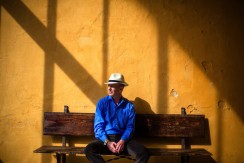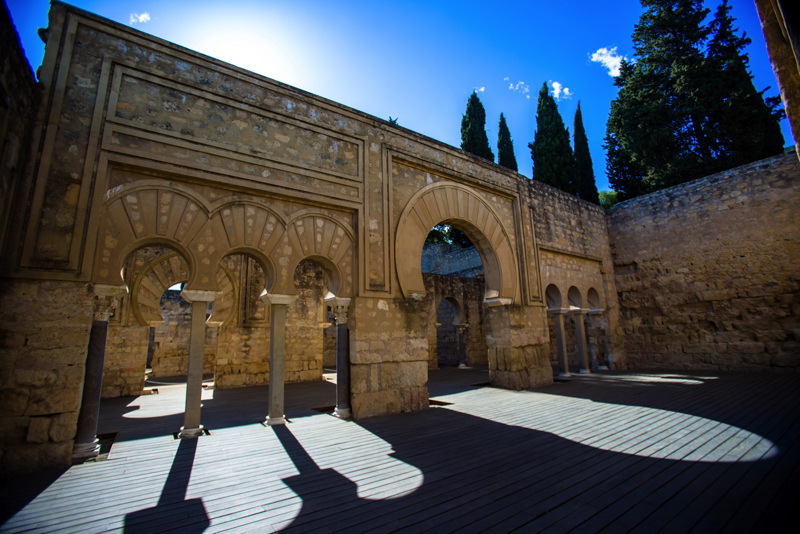Blog: Marion Milne
The producer of Blood & Gold: The Making of Spain on a journey from northern England to southern Spain
BBC Religion and Ethics in Salford is home to the man in the white panama hat, Simon Sebag Montefiore. Author of books on subjects as diverse as Jerusalem, Young Stalin and Catherine the Great, he is also presenter of a regular strand on BBC Four examining cities and destinations from a historical, cultural and religious perspective.
Following on from Jerusalem, Istanbul and Rome comes Blood and Gold: The Making of Spain with Simon Sebag Montefiore, an epic three parter that follows the story of Spain from the classical warrior Hannibal to the modern King Juan Carlos, with more than 2,000 years of action packed history in between.
We discovered from early on that Spain has been a country of buskers, street performers and wandering minstrels.
In the eighth century a man called Ali bin Naafi travelled to Cordoba in southern Spain from Baghdad. He was an expert guitarist, the inspiration behind the flamenco guitar. Bin Naafi abandoned the plectrum or pheasant feather used by guitarists to pluck their strings, and introduced the fast up and down strumming motion, the alzapua or falseta of flamenco guitar playing. Even today the music school in Cordoba is named after him.
Musicians and street artists also ply their trade outside the Alhambra Palace in Granada, from which of course the Alhambra Palace Theatre in Bradford takes its name. Transformed into a Royal Palace in the fourteenth century by the Nasrid Dynasty – Spain’s final Moslem rulers who held out for centuries in Granada while the rest of the country became Christian – it’s the most breathtaking of Spain’s awe-inspiring array of Moslem palaces. Sebag Montefiore compares the Court of Lions to a Moslem Golden Mien, with all four pillared walls conforming to the classical architectural rules of perfection.

En route we learn, via Cadiz, Cordoba and Seville – the latter cities both graced with splendid Moslem alcazars fitted out in marble and mosaic – how Spain was first a fiefdom of Carthage and then Rome, before the Moslem invasion of 711. The Moslem conquest left the greatest mark on the continent in terms of culture, music, landscape and language. And yet dig deeper and African, Roman and Visigoth influences all remain.
Hannibal, the most feared and famous general of the ancient world, came to Cadiz with his father in the third century BC and from there launched his fabled attack on Rome, crossing the Alps with his famous elephants shipped in on palm tree rafts from Carthage.
In 237BC Hannibal visited the remote island of Santa Petri in fast moving waters off the coast of Cadiz, now the haunt only of seagulls and the occasional windsurfer. In a dramatic filmed boat sequence, Sebag Montefiore retraces Hannibal’s journey. Then Santa Petri Island was home to one of the most splendid temples of antiquity, a shrine to the god Melqart. Before attacking Rome, as was the custom in ancient times, Hannibal sought the blessing of the gods of his ancestors.
Near Seville we visited the ruined Roman city of Italica and marvelled at how well it is preserved. Italica’s amphitheatre is the greatest and most complete outside of the Coliseum in Rome itself. There is a simple explanation for this. The Guadalqivir River meanders through a flat plain in this part of southern Spain. Eventually, it changed its course so the town of Italica was abandoned and its citizens moved to Seville. This, unlike so many Roman British towns such as Chester, means there are no layers of history on top to cover up the original Roman city.
Outside Cordoba we filmed in perhaps the greatest unknown Spanish site of all. Like Italica, Medina Al Zahara is also a ruined city. It was built as a statement of power by the Moslem Umayyad dynasty in the tenth century. It is on a vast scale carved into a hillside outside the city with views for miles around. It was home to concubines, slaves and man-eating lions kept for the entertainment of the Caliph or Sultan. This was the city of hanging gardens, running water and street lighting referred to by Alex Guinness as Feisal in Lawrence of Arabia: “I long for the vanished gardens of Cordoba. However, before the gardens must come the fighting.”
Even today in Cordoba people talk about “going to mass in the mosque”
In Cordoba itself is a magnificent Roman bridge, which remained the only bridge over that part of the Guadalqivir River until Franco’s era. It leads to the Mesqita, Cordoba’s extraordinary cathedral built inside a mosque. The mosque itself was created in the eight century from Visigoth pillars plundered from two centuries earlier. The cathedral was then built in the middle of the mosque after the Christian Reconquista of Spain from the twelfth century onwards – one culture getting a leg up from another. Even today in Cordoba people talk about “going to mass in the mosque”.
In the final episode Sebag Montefiore finishes his journey in Madrid, Spain’s capital, bringing the story up to date. En route it’s a rollercoaster ride through Spanish history. The journey from northern England to Spain was a bonanza: action-packed with vivid characters, stunning locations and colourful untold stories.
The first episode of Blood And Gold: The Making Of Spain With Simon Sebag Montefiore is on BBC4 at 9pm, 8 December

Leave a reply
Your email address will not be published.